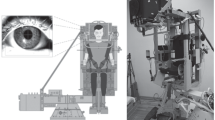Summary
Five members of the first Spacelab mission (STS-9) were tested on several occasions for weight-discrimination before and after the flight, and for mass-discrimination under microgravity in flight. Thresholds for mass-discrimination were higher than for preflight weight-discrimination by a factor of about 1.8, and there was no clear evidence of improvement throughout the ten day mission. Too few tests were conducted to monitor the improvement during the first two days of flight, when adaptation to weightlessness may have occurred. Subjects reported perceptual aftereffects of body heaviness for two or three days after the flight. Their weight-discrimination thresholds were raised during this period, when they were re-adapting to normal gravity. Incomplete adaptation to altered arm weight can only partly explain the raised threshold for mass- discrimination in microgravity. Differences in the sensory information available with and without gravity are discussed.
Similar content being viewed by others
References
Baumgarten R von, Benson A, Berthoz A, Brandt Th, Brand U, Bruzek W, Dichgans J, Kass J, Probst Th, Scherer H, Vieville T, Vogel H, Wetzig J (1984) Effects of rectilinear acceleration and optokinetic and caloric stimulations in space. Science 225: 208–212
Brodie EE, Ross HE (1984) Sensorimotor mechanisms in weight discrimination. Percept Psychophys 36: 477–481
Brodie EE, Ross HE (1985) Jiggling a lifted weight does aid discrimination. Am J Psychol 98: 469–471
Crawford SM, Kama WN (1961) Remote handling of mass. Wright-Patterson Air Force Base, Ohio. ASD TR 61–627
Engen T (1971) Psychophysics, Chap 2. In: Kling JW, Riggs LA (eds) Experimental psychology, Holt, Rinehart and Winston, New York, p 17
Gregory RL (1968) Perceptual illusions and brain models. Proc R Soc B 171: 279–296
Gregory RL, Ross HE (1967) Arm weight, adaptation, and weight discrimination. Percept Motor Skills 24: 1127–1130
Hershberger W, Misceo G (1983) A conditioned weight illusion: Reafference learning without a correlation store. Percept Psychophys 33: 391–398
Lund NJ, MacKay OM (1983) Sleep and the McCullough effect. Vision Res 23: 903–906
Mounoud P, Mayer E, Hauert CA (1979) Preparation of actions to lift objects of varying weight and texture in the adult. J Hum Mov Stud 5: 209–215
Müller GE, Schumann F (1889) Über die psychologischen Grundagen der Vergleichung gehobener Gewichte. Arch Ges Physiol 45: 37–112
Oldfield RC (1971) The assessment and analysis of handedness: the Edinburgh inventory. Neuropsychologia 9: 97–113
Rees DW, Copeland NK (1960) Discrimination of differences in mass of weightless objects. Wright-Patterson Air Force Base, Ohio. WADD Tech. Report 60-601
Reschke MF, Anderson DJ, Homick JL (1984) Vestibulospinal reflexes as a function of microgravity. Science 225: 212–214
Roland PE (1978) Sensory feedback to the cerebral cortex during movement in man. Behav Brain Sci 1: 129–171
Ross HE (1981a) How important are changes in body weight for mass perception? Acta Astronaut 8: 1051–1058
Ross HE (1981b) Mass-discrimination during weightlessness: plans for a spacelab experiment. Proc. 21st Convegno Internationale Scientifico Sullo Spazio. RIENA, Rome, 173–182
Ross HE (1985) Mass-discrimination: the development of a low-technology self-test procedure for space experiments. Earth-Orient Applic Space Technol 5: 95–99
Ross H, Brodie E, Benson A (1984) Mass discrimination during prolonged weightlessness. Science 225: 219–221
Ross HE, Bischof K (1981) Wundt's views on sensations of innervation: a reevaluation. Perception 10: 319–329
Ross HE, Gregory RL (1970) Weight illusions and weight discrimination — a revised hypothesis. Q J Exp Psychol 22: 318–328
Ross HE, Rejman MH, Lennie P (1972) Adaptation to weight transformation in water. Ergonomics 15: 387–397
Ross HE, Reschke MF (1982) Mass estimation and discrimination during brief periods of zero gravity. Percept Psychophys 31: 429–436
Ross HE, Schwartz E (1984) Can medication interfere with space research? An example from a mass-discrimination experiment on Spacelab 1. Proc 2nd Euro Symp on Life Sciences Res in Space, ESA/DFVLR, Cologne, ESA SP-212, 261–264
Webb WB (ed) (1982) Biological rhythms, sleep and performance. Wiley, New York
Weber EH (1834) The pulsu, resorptione, auditu et tactu. Annot. anat. et physiol. Koehler, Leipzig, translated by HE Ross, DJ Murray, and EH Weber. The sense of touch. Academic Press, London, 1978, p 55ff. and 121–122
Welch RB (1978) Perceptual modification: adapting to altered sensory environments. Academic Press, New York
Woodworth RS, Schlosberg H (1961) Experimental psychology. Methuen, London
Young LR, Oman CM, Watt DGD, Money KE, Lichtenberg BK (1984) Spatial orientation in weightlessness and readaptation to earth's gravity. Science 225: 205–208
Author information
Authors and Affiliations
Rights and permissions
About this article
Cite this article
Ross, H.E., Brodie, E.E. & Benson, A.J. Mass-discrimination in weightlessness and readaptation to earth's gravity. Exp Brain Res 64, 358–366 (1986). https://doi.org/10.1007/BF00237752
Received:
Accepted:
Issue Date:
DOI: https://doi.org/10.1007/BF00237752




